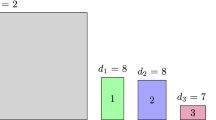Abstract
The one-dimensional cutting stock problem (1D-CSP) is one of the representative combinatorial optimization problems which arises in many industrial applications. Although the primary objective of 1D-CSP is to minimize the total length of used stock rolls, the efficiency of cutting processes has become more important in recent years. The crucial bottleneck of the cutting process often occurs at handling operations in semiautomated manufacturers such as those in the paper tube industry. To reduce interruptions and errors at handling operations in the paper tube industry, we consider a variant of 1D-CSP that minimizes the total length of used stock rolls while constraining (C1) the number of setups of each stock roll type, (C2) the combination of piece lengths occurring in open stacks simultaneously, and (C3) the number of open stacks. For this problem, we propose a generalization of the cutting pattern called the “cutting group,” which is a sequence of cutting patterns that satisfies the given upper bounds of setups of each stock roll type and open stacks. To generate good cutting groups, we decompose the 1D-CSP into a number of auxiliary bin packing problems. We develop a tabu search algorithm based on a shift neighborhood that solves the auxiliary bin packing problems by the first-fit decreasing heuristic algorithm. Experimental results show that our algorithm improves the quality of solutions compared to the existing algorithm used in a paper tube factory.
Similar content being viewed by others
References
Becceneri, J. C., Yanasse, H. H., & Soma, N. Y. (2004). A method for solving the minimization of the maximum number of open stacks problem within a cutting process. Computers and Operations Research, 31, 2315–2332.
Belov, G., & Scheithauer, G. (2003). The number of setups (different patterns) in one-dimensional stock cutting (Technical Report). Institute of Numerical Mathematics, Technische Universität Dresden.
Belov, G., & Scheithauer, G. (2006). A branch-and-cut-and-price algorithm for one-dimensional stock cutting and two-dimensional stock cutting and two-dimensional two-stage cutting. European Journal of Operational Research, 171, 85–106.
Belov, G., & Scheithauer, G. (2007). Setup and open-stacks minimization in one-dimensional stock cutting. INFORMS Journal on Computing, 19, 27–35.
Degraeve, Z., & Peeters, M. (2003). Optimal integer solutions to industrial cutting-stock problems: part 2, benchmark results. INFORMS Journal on Computing, 15, 58–81.
Degraeve, Z., & Schrage, L. (1999). Optimal integer solutions to industrial cutting stock problems. INFORMS Journal on Computing, 11, 406–419.
Fink, A., & Voß, S. (1999). Applications of modern heuristic search methods to pattern sequencing problems. Computers and Operations Research, 26, 17–34.
Foerster, H., & Wäscher, G. (1998). Simulated annealing for order spread minimization in sequencing cutting patterns. European Journal of Operational Research, 110, 272–281.
Foerster, H., & Wäscher, G. (2000). Pattern reduction in one-dimensional cutting stock problems. International Journal of Production Research, 38, 1657–1676.
Garey, M. R., & Johnson, D. S. (1979). Computers and intractability: a guide to the theory of NP -completeness. New York: Freeman.
Gau, T., & Wäscher, G. (1995). CUTGEN1: A problem generator for the standard one-dimensional cutting stock problem. European Journal of Operational Research, 84, 572–579.
Gilmore, P. C., & Gomory, R. E. (1961). A linear programming approach to the cutting-stock problem. Operations Research, 9, 849–859.
Gilmore, P. C., & Gomory, R. E. (1963). A linear programming approach to the cutting-stock problem—part 2. Operations Research, 11, 863–888.
Haessler, R. E. (1971). A heuristic programming solution to a nonlinear cutting stock problem. Management Science, 17, 793–802.
Haessler, R. E. (1975). Controlling cutting pattern changes in one-dimensional trim problems. Operations Research, 23, 483–493.
Madsen, O. B. G. (1988). An application of travelling-salesman routines to solve pattern-allocation problems in the glass industry. Journal of the Operational Research Society, 39, 249–256.
Makhorin, A. (2000). GLPK (GNU Linear Programming Kit). http://www.gnu.org/software/glpk/.
Umetani, S. (2009). Test instances for the paper tube cutting stock problem. http://www-sys.ist.osaka-u.ac.jp/~umetani/index-e.html.
Umetani, S., Yagiura, M., & Ibaraki, T. (2003). One-dimensional cutting stock problem to minimize the number of different patterns. European Journal of Operational Research, 146, 388–402.
Umetani, S., Yagiura, M., & Ibaraki, T. (2006). One-dimensional cutting stock problem with a given number of setups: a hybrid approach of metaheuristics and linear programming. Journal of Mathematical Modeling and Algorithms, 5, 43–64.
Vance, P. H. (1998). Branch-and-price algorithms for the one-dimensional cutting stock problem. Computational Optimization and Applications, 9, 211–228.
Vanderbeck, F. (1999). Computational study of a column generation algorithm for bin packing and cutting stock problems. Mathematical Programming, A86, 565–594.
Yanasse, H. H. (1997). On a pattern sequencing problem to minimize the maximum number of open stacks. European Journal of Operational Research, 100, 454–463.
Yanasse, H. H., & Lamosa, M. J. P. (2007). An integrated cutting stock and sequencing problem. European Journal of Operational Research, 183, 1353–1370.
Yuen, B. J. (1991). Heuristics for sequencing cutting patterns. European Journal of Operational Research, 55, 183–190.
Yuen, B. J. (1995). Improved heuristics for sequencing cutting patterns. European Journal of Operational Research, 87, 57–64.
Yuen, B. J., & Richardson, K. V. (1995). Establishing the optimality of sequencing heuristics for cutting stock problems. European Journal of Operational Research, 84, 590–598.
Author information
Authors and Affiliations
Corresponding author
Rights and permissions
About this article
Cite this article
Matsumoto, K., Umetani, S. & Nagamochi, H. On the one-dimensional stock cutting problem in the paper tube industry. J Sched 14, 281–290 (2011). https://doi.org/10.1007/s10951-010-0164-2
Published:
Issue Date:
DOI: https://doi.org/10.1007/s10951-010-0164-2




